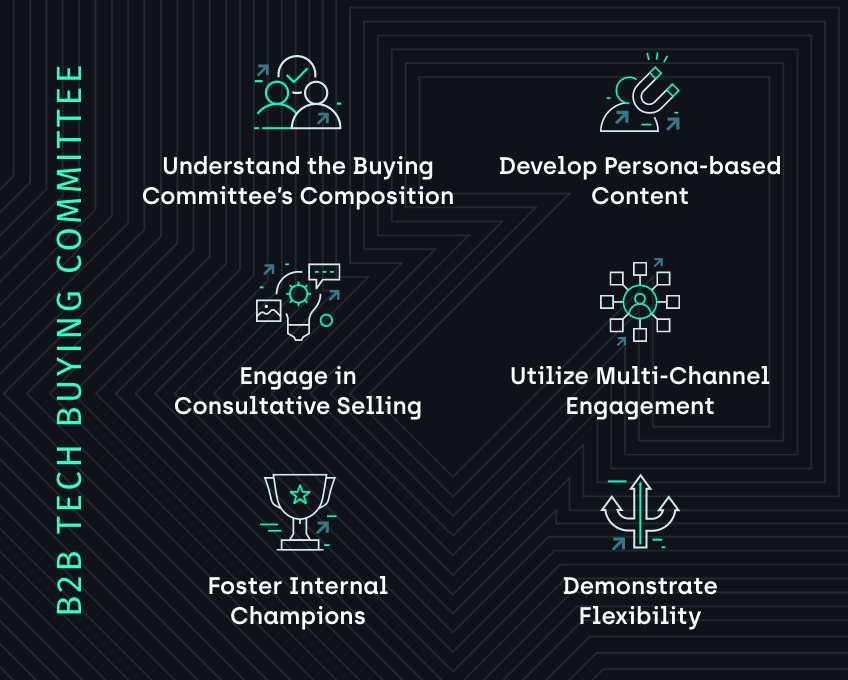In B2B technology sales, it’s crucial to understand the ever-changing dynamics of a buying committee. At every company, a group of experts from various departments, including IT, finance, operations, procurement, and the end-users themselves, help tackle the growing complexity, specialization, cost, and impact of tech purchases. A buying committee’s primary responsibility is to ensure that all technology investments align with the company’s strategic objectives, seamlessly integrate with current systems, and provide a favorable return on investment (ROI). Their collective decision-making helps reduce risk, strengthen organization-wide support, and address the varied needs of all stakeholders.
For vendors, understanding the dynamics, composition, and concerns of these working groups is key to effectively closing deals and gaining a competitive edge.
Each member of a buying committee brings their own unique experiences, challenges, and criteria for evaluating success. They each have their own unique set of interests and concerns. For instance, IT may examine integration and security, finance emphasizes ROI and cost, and procurement evaluates vendor reliability and compliance. It is crucial for B2B tech sales and marketing teams to adapt communications to effectively address these diverse perspectives. Doing so requires a thorough strategy that considers the viewpoints of various decision-makers and stakeholders, aligns with long-term business goals, and emphasizes the unique advantages of their technology solution.
As you attempt to find your way around a B2B technology buying committee, keep these factors in mind:
Understand the Buying Committee’s Composition
Before anything else, make sure you get to know each member of the committee and what their responsibilities are. For example, when presenting a software solution to a buying committee, here’s how to effectively engage with each member type:
- End-users – Be sure you show off how your offering prioritizes a user-friendly interface and robust customer support options. This will ensure that employees can enhance their workflow efficiency and minimize disruptions.
- Finance – Highlighting the potential cost savings and ROI that your product offers may capture the attention of financial officers seeking tangible benefits to enhance profitability and optimize resource allocation.
- Procurement – Sharing data on your company’s track record for reliability and compliance with industry standards can help address any concerns the committee members may have about potential risks. This will instill a sense of trust and confidence in your organization’s capacity to fulfill commitments and uphold operational integrity.
- IT – To attract the attention of those responsible for integration, compatibility, and security, it is important to highlight your tech’s capabilities around scalability, interoperability, and data protection.
- Marketing – You can boost confidence in the solution’s market viability and long-term success by highlighting its industry leadership and brand recognition aspects, such as your company’s established reputation, awards, or notable clientele, and your product’s awards and industry ratings. This will align with their focus on brand image and market positioning.
By recognizing and catering to the unique requirements of each committee member, you can enhance the chances of gaining their collective support.

Develop Persona-based Content
Creating content that resonates with every member of the buying committee can significantly increase your chances of success. Create persona-based materials that effectively address the concerns and objectives of each role within the committee. Ensure that your content is expertly crafted to showcase your deep understanding of their unique requirements while also establishing trust and credibility. For instance, you can customize your content to meet the specific needs of every individual in the buying committee. Here are a few methods to support each member of the committee:
- End-users – Share testimonials and success stories from employees who have directly experienced the advantages of your solution. Emphasize how your product enhances daily workflows, boosts productivity, and simplifies complex tasks to cater to the user’s desire for usability and efficiency.
- Finance – Present case studies that highlight the measurable ROI and cost savings achieved by other companies that have implemented your solution. Emphasize important metrics like payback period and total cost reduction to showcase their direct influence on the company’s profitability.
- Procurement – Craft content that showcases the reliability, commitment to compliance, and strong reputation of your solution. Incorporate case studies or references from reputable organizations in similar industries to address the concerns of procurement managers regarding risk mitigation and vendor selection.
- IT – Provide technical whitepapers that explore the complex aspects of your solution’s architecture, integration capabilities, and security features. Consider addressing technical concerns such as scalability, interoperability, and data protection to better align with the IT department’s priorities.
This customized content will help demonstrate how much you understand each member’s specific requirements—and will ultimately build trust and credibility by addressing their main concerns and difficulties.
Engage in Consultative Selling
Adopting a consultative selling approach can yield impressive results. Working closely with the buying committee is essential in order to gain a deep understanding of their challenges, goals, and constraints. By doing so, we can collaboratively develop a solution that effectively meets their needs. By establishing yourself as a reliable consultant rather than just a seller, you can forge a stronger bond with the committee and enhance your sway over the ultimate verdict. For instance:
- End-users – Connect with end-users to understand their challenges and concerns regarding existing processes or systems. Tailor your solution to address their specific needs and preferences, ensuring that it enhances their productivity and improves their overall user experience. Providing training sessions or personalized support can further showcase your dedication to addressing their challenges and delivering value.
- Finance – Analyze the main financial challenges faced by the CFO, such as budget limitations or the need to enhance profitability, and suggest a solution that is in line with their overall financial objectives. Providing tailored pricing options or adaptable payment plans can effectively address their unique challenges and enhance their willingness to invest in your solution.
- Procurement – Collaborate with procurement managers to gain a deep understanding of their specific challenges, including criteria for selecting vendors and ensuring compliance. Offer a comprehensive overview of your company’s financial stability, reliability, and compliance track record to alleviate concerns and instill trust in your tech and your company. Working closely with procurement during the buying process can also enhance efficiency and promote smoother decision-making.
- IT – Consult with the IT department to gain insights into their technical challenges, such as integration issues or concerns regarding data security. Through collaboration, define a solution that seamlessly integrates with their existing systems and meets their stringent security requirements. Offering continuous technical assistance and frequent updates can also address their worries and foster confidence in your solution.
Utilize Multi-Channel Engagement
Connect with committee members through various channels to ensure consistent visibility during the purchasing process. Various strategies can be implemented, such as personalized emails, active social media participation, targeted ads, and direct mail campaigns. Consistency in messaging across all channels and personalizing the communication to suit the preferences and behaviors of each committee member is crucial. Here are a few examples:
- End-users – User-facing content, including blog entries, infographics, and video tutorials, can help reach end-users by addressing their problems and providing solutions. Use social media platforms like Facebook and Instagram to share user-generated content and testimonials, creating a sense of community and trust among end-users.
- Finance – Based on their interests, send them personalized emails with in-depth financial analyses and ROI estimates. Put your LinkedIn skills to work by publishing thought leadership articles and sharing industry insights on optimizing finances.
- Procurement – Communicate with procurement managers through personalized email campaigns highlighting your company’s compliance certifications and track record for reliability. Utilize targeted advertising on industry-specific websites and publications to reinforce your reputation as a trusted vendor in the procurement space.
- IT – Technical webinars and online forums provide an excellent platform for IT professionals to connect, share experiences, and brainstorm solutions to common problems. Promote your product’s technical features and customer success stories through targeted ads on social media sites like LinkedIn.
Foster Internal Champions
Find people inside the target company who are enthusiastic about your solution and can act as advocates for it. By endorsing the group and speaking highly of their experiences, these individuals can sway the opinions of the buying committee. It is critical that you provide them with the tools and assistance they need to sell the benefits of your solution. Here are a few things that can help:
- End-users – Reach out to influential members or early adopters of your tech to see if they would be willing to promote your solution to their colleagues. You can incentivize them to spread the word about your solution by offering discounts or longer trial periods.
- Finance – Get to know financial controllers who can sell your solution to the CFO and the finance department by explaining its monetary value. Offer them exclusive access to training sessions or product demonstrations to increase their excitement about your solution.
- Procurement – Connect with buying agents or procurement managers who value dependable vendors and lasting relationships. Show them how your business has delivered value and fulfilled procurement needs in the past by providing case studies or references from similar organizations.
- IT – Establish rapport with IT team leaders or system administrators who recognize the technical advantages of your solution and can advocate for its implementation within the department. Give them access to your support staff or comprehensive technical documentation so they can resolve any technical issues.
Demonstrate Flexibility
Show how your approach can be customized to fit each client’s unique requirements. One way to achieve this is by offering flexible pricing options, tailoring your solution to meet specific needs, or ensuring strong support even after the sale. Here are a few ways to set your company apart and win over the buying committee:
- End-users – Offer customized training sessions or onboarding programs to ensure a seamless transition to your solution and optimize user adoption. Offer ongoing support and updates to address evolving user needs and feedback.
- Finance – When dealing with limited funds or other financial restrictions, be flexible with payment terms or financing options. Provide customizable pricing packages that allow them to choose the features and services that best align with their financial objectives.
- Procurement – Customize your contractual agreements to meet specific procurement requirements or compliance standards. Offer clear and adaptable pricing negotiations to establish trust and encourage a cooperative relationship with procurement stakeholders.
- IT – Emphasize the seamless integration of your solution with existing IT infrastructure or third-party applications. Offer scalable deployment options that allow the IT department to start small and expand as needed to meet growing demand or changing requirements.
The Buying Committee Mindset
Successfully winning over a B2B technology buying committee calls for a thoughtful and sophisticated approach. You must understand the committee’s composition, develop targeted content, leverage social proof, and engage in consultative selling. Additionally, you can further boost your effectiveness by employing multi-channel engagement, cultivating internal champions, and showcasing flexibility.
By implementing these strategies, you can successfully navigate the complexities of B2B technology sales and position yourself as the preferred vendor. When you’re ready to tailor your content and marketing strategies to impact buying committees in your market segment, reach out to Yeager to help your marketing team deliver powerful results and make an impact across the buying committee.

